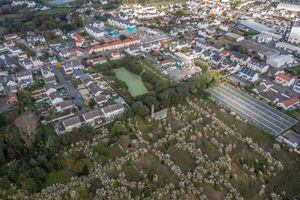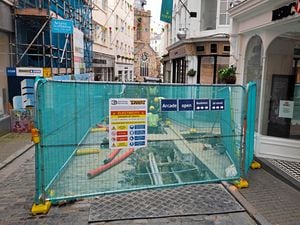OPINION: Critical mass
Trevor Cooper considers some of the problems with the current Island Development Plan

MANAGING car use has become a pivotal factor in new housing developments, impacting on several large-scale projects.
Shared mobility and active travel are new buzz words lauded by action groups and like-minded politicians, not to mention developers who make more profit from floor space than parking spaces. This is not a criticism as the former are entitled to express their opinions and the latter are in business to make profit.
I have previously suggested traffic management measures for both the Bridge and Town seafronts but added that the island does not need to become a network of one-way, prohibited or residents-only roads just to appease every mammoth residential, commercial or civic development.
Neither is it necessary, as yet, to needlessly confine home-buyers to public transport, e-bikes and car shares.
Keen buyers of modern flats and houses on new estates might believe they’ll embrace the new ideal but need or notion will soon tempt some to revert to owning their own set of wheels. Long-term and free coastal car-parking in the vicinity of the Bridge, Delancey and Halfway will be in even greater demand once some, if not all, of the proposed shared-mobility-scheme homes are built within the 800 or so new flats and houses scheduled to be built within a mile of each other.
In view of those numbers, the authorities are right in trying to address the high levels of commuter and school-run traffic converging on St Peter Port’s urban centre. Some will say this is not unique to Guernsey and is actually less of a problem than in other thriving towns and cities worldwide. More than likely, those people join traffic queues along the main arterial routes into Town, whereas peak-time traffic from the north of the island has to queue interminably in minor roads waiting for a chance to join the main road queues into Town. Using drone cameras at peak times would soon show the disparity in time, speed and distance experienced by drivers in different parts of the island.
And yet there is a way to ease not only some of Guernsey’s vehicular logjams but also rescue the north of the island’s heritage-rich landscape from disappearing under a converging roofscape.
The fault lies with the current Island Development Plan, approved by our deputies in 2016 and drafted by our planners long before that, when market constraints meant very little house-building took place in Guernsey. Having put all its eggs in ‘local-centre’ baskets the IDP is struggling to accommodate first-time buyers coming home to roost. Local centres are fine in nationwide town and country planning but not on a 23-square-mile island.
The IDP policies are also criticised for allowing bulk development of building sites irrespective of their suitability or impact on the locality. This is apparent on individual plots as much as large estates.
It may be too late to turn the tide on the north-eastern developments currently making our local headlines but an important precedent will come from the Guernsey Housing Association converting Kenilworth Vinery and Fontaine Vinery in St Sampson’s for residential use.
Guernsey’s once emblematic growing industry declined from the late 1970s. Increased oil prices and export costs and competition from Holland and the Canary Islands made horticulture unsustainable on a commercial scale. The skeletal remains of massive investments in modern glasshouses were left to rack and ruin. Applications by beleaguered growers to replace them with new housing were vigorously rejected, correctly at the time, as horticultural sites had to revert to agricultural use. But that has been the case for more than 40 years and the time has come to reconsider the rule in a pragmatic yet mindful way.
As previously stated on this page, and also raised by Deputy Steve Falla in last week’s States debate, more than 250 derelict vineries have been pinpointed by the States in the past, not that the floodgates need opening by using them all at once or even every part of them.
At the time, 180 were immediately adjacent to land in agricultural use. Those could remain exempt from residential development. Taken a stage further, the States should offer a grant or its own resources, including temporary labour, to help clear the site and return it to agricultural use to compensate for the alarming loss of agrarian land to domestic use under the current IDP.
A total of 15 of the redundant vineries were located in or near the fabled ‘local centres’. Planners may already have them earmarked for future housing but now should reconsider how that would impact on the wider vicinity. The remaining 55 derelict vineries should be surveyed for potential development and a sensible conversation had with their owners.
In any event and on no account should the entire site of a derelict vinery be used for housing, perhaps only one-third of the space available, with time-penalty covenants attached to the planning permission that the vinery owner or developer clears and returns to grass the remainder of the site. Not only will this improve a locality’s green agenda, it spreads the burden of traffic further afield.
There is growing support for the commendable principles of active travel and shared mobility, but let it remain a personal choice. It might take a decade or even a generation to become common practice and wherever appropriate new developments should maintain responsible car use in the meantime. It might mean fewer houses on site, but that may be preferable in some cases.
But is the Development & Planning Authority open to suggestions? Not according to last week’s scrutiny panel hearing, when the DPA said it would review individual key areas of the IDP rather than embark on a more thorough process.
Merely tinkering with the IDP is not enough. Its policies are backfiring and planners are hamstrung by its flawed rationale. Do not risk emulating our previous population policy, so meddled with that only three people within the housing authority are said to have understood it.
Before matters worsen, the DPA needs to suspend the current IDP altogether, instead use it as a guide and allow the planning authorities discretionary powers until an altogether better plan is hatched.





